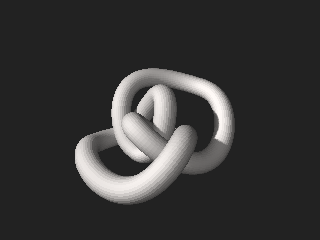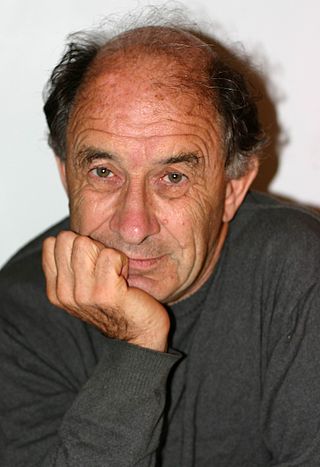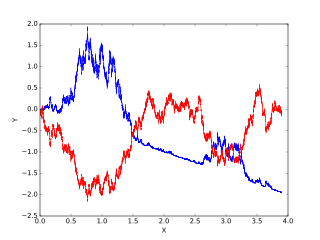Related Research Articles

Algebraic geometry is a branch of mathematics which uses abstract algebraic techniques, mainly from commutative algebra, to solve geometrical problems. Classically, it studies zeros of multivariate polynomials; the modern approach generalizes this in a few different aspects.

Discrete mathematics is the study of mathematical structures that can be considered "discrete" rather than "continuous". Objects studied in discrete mathematics include integers, graphs, and statements in logic. By contrast, discrete mathematics excludes topics in "continuous mathematics" such as real numbers, calculus or Euclidean geometry. Discrete objects can often be enumerated by integers; more formally, discrete mathematics has been characterized as the branch of mathematics dealing with countable sets. However, there is no exact definition of the term "discrete mathematics".

In mathematics, topology is concerned with the properties of a geometric object that are preserved under continuous deformations, such as stretching, twisting, crumpling, and bending; that is, without closing holes, opening holes, tearing, gluing, or passing through itself.

Vladimir Igorevich Arnold was a Soviet and Russian mathematician. He is best known for the Kolmogorov–Arnold–Moser theorem regarding the stability of integrable systems, and contributed to several areas, including geometrical theory of dynamical systems theory, algebra, catastrophe theory, topology, real algebraic geometry, symplectic geometry, symplectic topology, differential equations, classical mechanics, differential geometric approach to hydrodynamics, geometric analysis and singularity theory, including posing the ADE classification problem.
Noncommutative geometry (NCG) is a branch of mathematics concerned with a geometric approach to noncommutative algebras, and with the construction of spaces that are locally presented by noncommutative algebras of functions, possibly in some generalized sense. A noncommutative algebra is an associative algebra in which the multiplication is not commutative, that is, for which does not always equal ; or more generally an algebraic structure in which one of the principal binary operations is not commutative; one also allows additional structures, e.g. topology or norm, to be possibly carried by the noncommutative algebra of functions.
Lists of mathematics topics cover a variety of topics related to mathematics. Some of these lists link to hundreds of articles; some link only to a few. The template to the right includes links to alphabetical lists of all mathematical articles. This article brings together the same content organized in a manner better suited for browsing. Lists cover aspects of basic and advanced mathematics, methodology, mathematical statements, integrals, general concepts, mathematical objects, and reference tables. They also cover equations named after people, societies, mathematicians, journals, and meta-lists.

Itô calculus, named after Kiyosi Itô, extends the methods of calculus to stochastic processes such as Brownian motion. It has important applications in mathematical finance and stochastic differential equations.

In mathematics, a manifold is a topological space that locally resembles Euclidean space near each point. More precisely, an -dimensional manifold, or -manifold for short, is a topological space with the property that each point has a neighborhood that is homeomorphic to an open subset of -dimensional Euclidean space.
In mathematics, specifically in symplectic topology and algebraic geometry, Gromov–Witten (GW) invariants are rational numbers that, in certain situations, count pseudoholomorphic curves meeting prescribed conditions in a given symplectic manifold. The GW invariants may be packaged as a homology or cohomology class in an appropriate space, or as the deformed cup product of quantum cohomology. These invariants have been used to distinguish symplectic manifolds that were previously indistinguishable. They also play a crucial role in closed type IIA string theory. They are named after Mikhail Gromov and Edward Witten.

Masaki Kashiwara is a Japanese mathematician. He was a student of Mikio Sato at the University of Tokyo. Kashiwara made leading contributions towards algebraic analysis, microlocal analysis, D-module theory, Hodge theory, sheaf theory and representation theory.
In mathematics, secondary calculus is a proposed expansion of classical differential calculus on manifolds, to the "space" of solutions of a (nonlinear) partial differential equation. It is a sophisticated theory at the level of jet spaces and employing algebraic methods.
In mathematics, real algebraic geometry is the sub-branch of algebraic geometry studying real algebraic sets, i.e. real-number solutions to algebraic equations with real-number coefficients, and mappings between them.
Graduate Texts in Mathematics (GTM) is a series of graduate-level textbooks in mathematics published by Springer-Verlag. The books in this series, like the other Springer-Verlag mathematics series, are yellow books of a standard size. The GTM series is easily identified by a white band at the top of the book.
In algebraic geometry, a period is a number that can be expressed as an integral of an algebraic function over an algebraic domain. Sums and products of periods remain periods, such that the periods form a ring.
The study of manifolds combines many important areas of mathematics: it generalizes concepts such as curves and surfaces as well as ideas from linear algebra and topology. Certain special classes of manifolds also have additional algebraic structure; they may behave like groups, for instance. In that case, they are called Lie Groups. Alternatively, they may be described by polynomial equations, in which case they are called algebraic varieties, and if they additionally carry a group structure, they are called algebraic groups.
Mathematics is a broad subject that is commonly divided in many areas that may be defined by their objects of study, by the used methods, or by both. For example, analytic number theory is a subarea of number theory devoted to the use of methods of analysis for the study of natural numbers.

Alexander Nikolaevich Varchenko is a Soviet and Russian mathematician working in geometry, topology, combinatorics and mathematical physics.
Most of the terms listed in Wikipedia glossaries are already defined and explained within Wikipedia itself. However, glossaries like this one are useful for looking up, comparing and reviewing large numbers of terms together. You can help enhance this page by adding new terms or writing definitions for existing ones.
References
- ↑ Baryshnikov, Y.; Ghrist, R. Euler integration for definable functions, Proc. National Acad. Sci., 107(21), 9525–9530, 25 May 2010.
- ↑ McTague, Carl (1 Nov 2015). "A New Approach to Euler Calculus for Continuous Integrands". arXiv: 1511.00257 [math.DG].
- ↑ Schapira, P. "Cycles Lagrangiens, fonctions constructibles et applications", Seminaire EDP, Publ. Ecole Polytechnique (1988/89)
- ↑ Schapira, P. Operations on constructible functions, J. Pure Appl. Algebra 72, 1991, 83–93.
- ↑ Schapira, Pierre. Tomography of constructible functions Archived 2011-10-05 at the Wayback Machine , Applied Algebra, Algebraic Algorithms and Error-Correcting Codes Lecture Notes in Computer Science, 1995, Volume 948/1995, 427–435, doi : 10.1007/3-540-60114-7_33
- ↑ Viro, O. Some integral calculus based on Euler characteristic, Lecture Notes in Math., vol. 1346, Springer-Verlag, 1988, 127–138.
- ↑ Baryshnikov, Y.; Ghrist, R. Target enumeration via Euler characteristic integrals, SIAM J. Appl. Math., 70(3), 825–844, 2009.
- Van den Dries, Lou. Tame Topology and O-minimal Structures, Cambridge University Press, 1998. ISBN 978-0-521-59838-5
- Arnold, V. I.; Goryunov, V. V.; Lyashko, O. V. Singularity Theory, Volume 1, Springer, 1998, p. 219. ISBN 978-3-540-63711-0